|
|
|
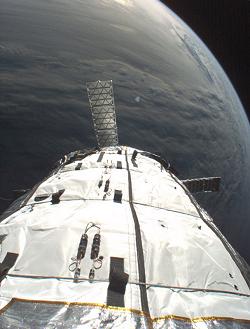
Credits: Bigelow
Aerospace
The successful orbiting of the Bigelow
Aerospace Genesis I module
was the most significant event in commercial spaceflight
during 2006.
|
|
|
In the previous Commercial Stairway to Space Timelines for
2006, 2005,
and 2004,
I laid out what I considered a realistic set of milestones that
would lead to a scenario in which private, commercial activity dominates
human spaceflight activity by the middle of the next decade. So
far the private spaceflight industry has shown solid progress up
that path. A number of projects have hardware in or near operation
and well over a billion dollars of investment is currently committed
to new manned space transport vehicles, commercial spaceports, space
habitats, and related infrastructure projects.
Below I first review what
actually happened in 2006 versus my expectations.
As in previous years, some predictions came about and others did
not. For example, the first flight of the SpaceX
Falcon 1 failed shortly after launch and no new private suborbital
vehicles broke the 100 km borderline to space. On the other hand,
the orbiting of the Genesis I space habitat from Bigelow
Aerospace was a huge success and accelerated the company's plans
for space habitat development.
I'll note that Bigelow Aerospace illustrates the difficulty in
predicting the course of space development. Five or so years ago
it would have seemed quite preposterous to predict that a privately
financed space hotel program would get into orbit before
the appearance of low cost space transports. Yet it looks quite
possible that a Sundancer will arrive in orbit as early as 2009
and wait there for perhaps a year or two before visitors start arriving
to take advantage of its capabilities.
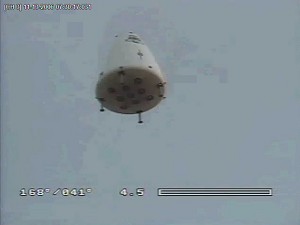
Credits: Blue
Origin
Blue Origin's Goddard prototype suborbital space vehicle
during its first
flight in November 2006.
As illustrated by Robert Bigelow's steady support for his projects,
the wealth of space
angel investors continues to be the primary fuel propelling
the entrepreneurial space movement forward. However, in 2006 we
saw NASA money via the COTS
and Centennial
Challenges programs also enter into the picture. In the coming
years we may finally see institutional investment (e.g. venture
capital funds) enter the private spaceflight industry if the market
for space tourism proves to be viable. The COTS contractors may
also obtain such funding if the NASA commitment to buying cargo
delivery services is deemed to be solid and secure. (I should point
out that Spacehab
got all private funding for its Shuttle cargo
modules back in the early 1990s. Similarly, Orbital
Sciences funded the Pegasus
vehicle privately.)
A wild card entered the NewSpace game in the past year. It's possible
that one or more of the large Old Space mainstream aerospace
companies may become a serious participant in commercial human spaceflight
development. For example, it was a surprise to me and other observers
of the NewSpace arena when Bigelow and Lockheed-Martin announced
a joint study into the use of the Atlas V for delivery of passengers
to Bigelow orbital habitats. It's quite conceivable in the coming
years we will see one of the giants collaborate with an entrepreneurial
company developing an orbital or suborbital vehicle. It's perhaps
useful to remember that in the early days of the microcomputer there
was lots of talk about the startups surpassing the old mainframe
dinosaur companies but it was IBM's entry into the field, in collaboration
with a tiny unknown software company called Microsoft, that greatly
accelerated the spread of personal computers.
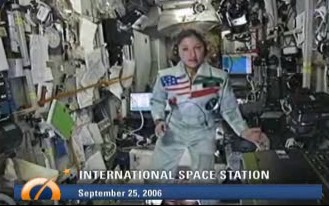
Credits: anoushehansari.com
In October 2006 Anousheh
Ansari became the fourth
"personal spaceflight participant" to go to the ISS.
As I indicated in the previous timelines, my intention is not really
to predict in detail what will happen. That is obviously impossible,
but rather simply to highlight the existence of a broad and substantial
movement towards private spaceflight. A given company might fail
to achieve its publicized goals, such as, say, the development of
a suborbital passenger vehicle, but there remain other companies
that will eventually reach that same goal. There is a growing robustness
and vitality in the NewSpace
industry that will allow it to tolerate some failures while maintaining
its overall momentum.
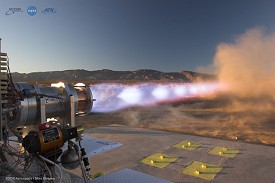
Credits Mike Massee / XCOR
XCOR in December
2006 tested
a LOX/Methane engine it built
as a subcontractor to ATK under a NASA contract.
Furthermore, I continue to emphasize that these commercial spaceflight
projects do not violate any laws of physics or economics. The remarkable
fact is that we have entered a period in which human spaceflight
development outside of government is not only feasible but is actually
happening and at a quickening pace.
|

Armadillo
Aerospace's Pixel in flight at the 2006
X Prize Cup.
Pixel did not win the Lunar
Lander Challenge but it did fly four
times successfully within a time span of three days (twice, in
fact, on one day), illustrating again that rocket vehicles can fly
repeatedly and with fast turnaround.
|
|
This first table reviews progress since the first
timeline was created. The second
table below lays out an updated, revised timeline. (Since
lowering the cost of transport from earth to orbit is crucial to
all important goals in space, that category is given the greatest
emphasis here.) See the 2004
discussion of what could delay or accelerate the scenario
laid out here.
|
|
|
Access to Space
- Several private organizations begin test flights of full
scale reusable suborbital vehicles.
- SpaceX
carries out three launches of the Falcon 1 in 2006.
- The Rocket
Racing League holds its first demonstration events in
2006.
- The X Prize Cup expands
to a 2-day event and many more rockets fly and many more
people attend that did in October 2005.
- NASA announces in June the winner(s) of the Commercial
Orbital Transportation System (COTS) contracts for ISS
cargo resupply. This provides money and credibility to the
winners, who in turn may use the contracts to raise additional
private investment for vehicle development.
- Unmanned reusable sounding rockets such as those from
UP Aerospace
and Beyond-Earth
Enterprises start to fly small payloads (science experiments,
student projects, memorabilia, etc.) They will build businesses
based on fees for such flights.
- NASA announces the purses and detailed requirements for
the two
suborbital vehicle Centennial Challenges that were first
revealed at the XP Cup in 2005. Several companies sign up
to contest for the competition.
Other Developments
- Bigelow
Aerospace in early 2006 launches its first Genesis 1/3
scale inflatable habitat module on a Russian Dnepr rocket.
- The primary suborbital market is tourism but additional
markets develop in the areas of:
- High altitude imaging & reconnaissance
- Experiments in microgravity, astronomy, atmospheric
studies, magnetosphere research, & other scientific
areas
- Release of missile defense targets
- Air show exhibitions
- ZERO-G
expands its service to at least one other city in the US.
- SpaceShot
and other skill game enterprises become a new space business
that gives people with modest incomes a shot at getting
a spaceflight ride.
- Daisuke
Enomoto will become the fourth tourist to go to the
ISS.
- Space
Services Inc. flies in 2006 a payload of cremated remains
on the first Falcon 1 to launch from Vandenberg. With the
availability of regular, low cost space access via the Falcon
1 vehicle, (and launched from a site easily accessible in
the US for friends and families of the deceased) the company
finally builds a successful space burial business.
|
Access to Space
- There were no private RLV flights to 100km in 2006 but
several companies, such as Blue
Origin, and Rocketplane,
TGV Rockets,
Scaled Composites,
etc. continued vigorous development programs. Armadillo
Aerospace did not win the Lunar Lander Challenge but
did fly its rocket powered VTOL vehicle four times within
3 days at the X PRIZE Cup. Virgin Galactic unveiled a model
of the interior of the SpaceShipTwo. Blue Origin began low
altitude test flights of its Goddard prototype vehicle.
- The first Falcon 1 fell back into the water soon after
launch due to a fire caused by a leak in an engine fuel
line. This led to a premature cut off of the engine. The
vehicle and its launch procedures have been significantly
upgraded and another launch attempt will occur in early
2007.
- The Rocket
Racing League did not hold any demo races in 2006 but
there was progress with the development of the vehicle and
in the introduction
of three rocket teams.
- The X PRIZE Cup was
significantly enhanced over the 2005 event. There were many
more rocket launches and it included the Lunar Lander and
Space Elevator challenge competitions. See the review
here.
- SpaceX
and Rocketplane
Kistler won the COTS contracts, which will total $500M
by 2010 if they meet their milestones. The companies are
to demonstrate a capability to deliver cargo to the ISS.
However, both companies plan crew capability as well. Other
companies can compete for the phase 2 contracts in 2010
for regular cargo deliveries to the ISS.
- The flight of the first UP Aerospace SpaceLoft vehicle
fell far short of the the intended altitude due to a malfunction.
The company did have a full manifest of commercial items
on board and they report that sales for future flights are
doing well. Beyond-Earth also carried out medium altitude
flights with commercial payloads aboard. Masten
Space Systems, which plans to pursue this type of market,
reported progress with development of its reusable launch
vehicle.
- The Lunar Lander Challenge competition event was held
for the first time at the XP Cup. Three teams registered
but only Armadillo Aerospace had a vehicle ready to compete.
AA did not win the event but did demonstrate reusability
and fast turnaround with 4 flights within 3 days. See details
and pictures in the X
Prize Cup review.
Other Developments
- Bigelow launched the Genesis 1 and it worked far better
than expected. The company decided to accelerate plans for
larger habitats as a result.
- Market development for suborbital spaceflight seems to
be moving along. Virgin Galactic and other suborbital space
tourism companies indicated they now have a significant
number of deposits and full payments for tickets. VG says
their flights are sold out for the first couple of years
of operation.
- ZERO-G
seems to be doing very well. They have now bought a plane
rather than leasing one and they began flights from the
Shuttle runway at KSC.
- SpaceShot
opened for business and is planning some new variations
on its skill game offerings.
- Enomoto's ride was canceled due to health problems. In
his place Anousheh
Ansari flew instead. Her flight got lots of positive
publicity worldwide.
- Plans for space burial continue to develop but the lack
of flight opportunities in 2006 was a setback.
|
- Bigelow
Aerospace and Lockheed-Martin announced an agreement
to study the use of the Atlas V to provide crew and passenger
service to Bigelow Habitats.
- The Spaceport
America project in New Mexico continued to develop.
Several commercial spaceport projects in the US, Canada,
Singapore and elsewhere were introduced, though how many
will ever get past the planning stage isn't known yet.
- AirLaunch
LLC continued to progress through the milestones required
by its DARPA contract
for development of an unmanned orbital launch system.
- Jim Benson left SpaceDev
to start Benson
Space, which will develop and market the Dream
Chaser vehicle (based on the NASA HL-20 design). However,
the company will contract with SpaceDev to build the vehicle.
- PlanetSpace
did not win a COTS contract but did announce its intention
to continue development of the Silver Dart (based on the
FDL-7 glider design from the 1960s) and compete for the
second phase COTS contracts. They also announced plans for
suborbital space tourist flights.
- XCOR won
a NASA contract along with ATK to develop LOX/Methane rocket
engines. A prototype engine was test fired in December.
XCOR also continued development of the Rocket Racing vehicle.
The company continued work on its Xerus suborbital space
vehicle.
- Garvey
Space, in collaboration with a group at Cal
State Long Beach and using a grant from the military,
test
flew a very low cost reusable booster to low altitude.
The plan is for incremental development leading to a vehicle
capable of placing a nanosat in LEO.
- Infrastructure companies providing supports services for
equipment of the space tourist industry began to appear.
For example, Orbital
Outfitters announced that it will offer low cost pressure
suits for suborbital passenger spaceflights.
- In December of 2006 the FAA Commercial Space Transportation
office released its rules
regulating private human spaceflight.
|
|
|
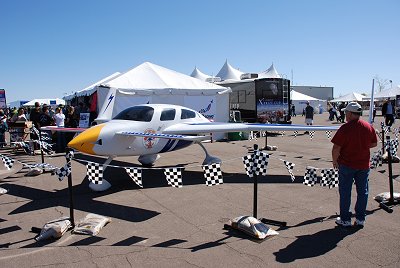
The first Rocket
Racer was unveiled during the 2006 X Prize Cup.
Racing
Racing League events will start in 2007. Velocity
Aircraft supplied the
airframe and XCOR
built the engine (XR-4K14,
1,500 lbf LOX/kerosene) and
assembled the vehicle.
Note: In the following table where I list particular firms,
my intention is only to show that there exists one or more real
companies that could accomplish a given milestone. There will very
likely be other companies that accomplish the same thing, perhaps
even sooner.
It's also certain that some companies listed here will not achieve
their goals and will perhaps disappear completely from the scene.
That is the nature of the commercial environment. The point here
is only to indicate that the private sector is capable in principle
of attaining a particular goal and that eventually some company
will do it.
|
|
|
|
| 2007-2008 |
SpaceX will
carry out two to three launches of the Falcon 1 in 2007.
SpaceX also will begin Falcon 9 booster static fire tests
in early 2007. First launches will occur in 2008. The three
COTS demonstration flights should start by late 2008 or early
2009.
Rocketplane
Kistler begins test flights of the K-1 vehicle in 2008.
Lockheed-Martin will announce plans either to develop the
Atlas V for passenger use (see Bigelow
study) or to become a close partner with one of the NewSpace
companies developing an RLV. One or more of the other major
aerospace corporations will follow suit and also partner or
buy out a NewSpace firm.
Suborbital RLVs:
Mojave
Aerospace Ventures (Burt Rutan's firm) will roll out
the SpaceShip 2 and White Knight 2 vehicles in late 2007
and begin test flights in 2008. Virgin Galactic will start
passenger flights in late 2008 or early 2009.
Rocketplane
postponed its first commercial passenger suborbital flight
to 2009 due to the effort put into the COTS K-1 project.
Test flights should begin in 2008.
XCOR is
working on the Xerus, which carries one passenger, as funding
and time permit. The company has not said much else but
I'm guessing it could fly by 2008.
Blue Origin
will fly its unmanned prototypes frequently (couple of times
a month at least) to increasing altitudes during this period.
The company says it aims for commercial passenger suborbital
flights in 2010.
Armadillo
Aerospace will continue its build a little - fly
a little approach, steadily increasing the capability
of its VTOL vehicles. I expect they will reach 100 km before
2009. They are favorites to win both levels of the Lunar
Lander Challenge at the 2007 X PRIZE Cup.
Masten-Space
Systems will do test flights of its VTOL prototypes
in 2007. If they obtain funding, they could have a high
altitude vehicle by 2008.
TGV-
Rockets has carried out advanced design reviews for
its Michelle vehicle. If funding available, they could fly
by 2009.
Benson
Space says they will begin passenger service with Dream
Chaser by 2009. So test flights should begin in 2008.
Suborbital RLVs outside the US:
- UK
- Starchaser
- Thunderbird development continues towards the goal
of passenger flights in 2009.
- Canada:
- PlanetSpace
- The company has not given a clear picture of its hardware
status but has indicated suborbital flights of its Canadian
Arrow and/or Silver Dart systems could begin during
the 2008-2009 time frame.
- Da
Vinci - Tests of its new XF1
vehicle are supposed to start in 2007.
- Romania
- Arca
Space - test flights of the full Stabilo vehicle
system will begin in 2007.
- Russia
- Explorer
- this space tourist vehicle, financed and run by a
collaboration of Russian and American companies, including
Space Adventures, should be flying in the 2008 time
frame.
- South Korea
- C&Space
- its LOX/Methane engine has reached an advanced testing
stage. The company has a US partner to design a complete
vehicle but no time table has been released.
Other suborbital projects listed here
may also obtain funding and fly vehicles by 2008.
The
Lunar Lander Challenges (both levels 1 and 2) will be
won at the X PRIZE Cup in 2007.
AirLaunch
LLC places a small payload into orbit on the first demo
flight of its QuickReach vehicle in 2008.
|
- Bigelow
Aerospace will launch the second Genesis prototype space
habitat module in early 2007. If that is a success, the
company has indicated that it will lay out a more detailed
development plan and schedule for its next generation of
space habitats.
- Bigelow Aerospace will announce by the end of 2008 that
it has a contract with at least one country, and probably
several, for the rental of space and time on on of the company's
space habitats in the 2010-2015 time frame. These will be
countries with no previous human spaceflight programs. Transportation
arrangements for taking these astronauts to the habitats
will be made with commercial space transport companies.
- By the end of 2007, I expect that the total number of
people who have placed deposits or paid the full amount
for tickets to fly on suborbital tourist vehicles will be
in the 500 to 1000 range.
- Test flights of suborbital spaceflight vehicles will become
a common occurrence during 2008.
- I expect the first paid passenger flight to 100km will
take place by late 2008 or early 2009.
- In 2008 around a hundred thousand people will attend the
annual X PRIZE Cup to
observe the rocket competitions, exhibitions, and the Rocket
Racing League event.
- The Rocket
Racing League will begin demonstration events in 2007
and will increase the number of racing teams to 5 or 6 from
the current three. The racing circuit will be in full swing
in 2008. They will obtain a major sponsor similar to Red
Bull's sponsorship of air
racing.
- Space
Adventures continues to fly one space tourists to the
ISS each year, restricted by the availability of only one
seat per year on the Soyuz flights.
- Flying small payloads consisting of science experiments,
student projects, memorabilia, etc. on very low cost suborbital
rockets will become increasingly popular. The refurbishable
sounding rocket type of vehicles from companies like UP
Aerospace and Beyond-Earth
Enterprises will dominate until unmanned RLVs with controlled
landings such as the XA-1.0 from Masten
Space Systems begin to fly. The sounding rocket guys
will respond by going to much higher altitudes.
- More support services and products for space tourism and
NewSpace activities begin to appear. For example, training
facilities for pilots and support staff for space tourist
vehicles will begin to open.
- ZERO-G
starts to operate in several cities and also finally gets
a contract with NASA to provide flights to carry out astronaut
training, microgravity research, etc.
|
| 2009-2010 |
SpaceX with its Falcon 9/Dragon system and Rocketplane Kistler
with its K-1 RLV will complete by 2010 their successful series
of demonstration flights under their COTs Phase 1 contracts.
They each win Phase II contracts to deliver cargo to the ISS.
The COTS successes lead to major changes in NASA's exploration
architecture. Development of the Ares vehicles is halted and
instead launch of the lunar exploration systems will be carried
out by commercial space transport companies. The new architecture
will rely on in space assembly of smaller components and the
use of dry launch in which vehicles obtain fuel from orbital
fuel storage systems.
One or more of the suborbital RLV developers start launching
small expendable second stages to take small payloads to orbit.
By 2010, suborbital transportation grows into ~$100M to $200M
industry by flying 1000-2000 space tourists per year and by
serving other suborbital markets such as science and educational
payloads and high altitude photography. Launch services in
several countries become available.
One of the large mainstream aerospace companies announces
plans to develop a low cost space transport system to go after
space tourism, Bigelow, and ISS resupply markets.
Another large company announces that it is buying one of
the suborbital RLV firms.
|
By 2010 Bigelow
Aerospace launches the Sundancer
space habitat, which can hold a crew of three.
The German led AMSAT
P5A mission succeeds in sending in placing a spacecraft
in orbit around Mars in 2009. (See also Go-Mars.de)
Orbital
Recovery launches the first comsat rescue mission in 2009.
NASA finally agrees to the first pure data
purchase contract for a science mission. This will involve
a company like SpaceDev,
that builds and flies a spacecraft on its own to carry out
a science mission such as prospecting
a near earth asteroid. NASA will simply pay for the data
returned and will have no involvement with the details of
the spacecraft or how the mission is carried out.
|
| 2011-2012 |
By 2012 vehicles developed for the COTS ISS resupply program
begin regular crew and cargo service to the ISS and to a Bigelow
habitat in equatorial orbit.
Bigleow begins design work on an earth orbit to lunar transport
vehicle - the Nautilus Moon Cruiser - based on its
inflatable structures technology.
One or more of the suborbital RLV developers such as Blue
Origin successfully launches a fully reusable two-stage
system capable of taking a crew of two and/or a small payload
to orbit.
|
A 3 person crew is delivered to the Bigelow Sundancer module
by 2011 by SpaceX or Kistler.
Inspired by the success of the commercial space companies
and the falling price of access to LEO, several wealthy associations
and private organizations of diverse ideologies and philosophies
come into being with the goal of building a large scale habitat
in orbit or on the Moon with hundreds of residents by 2025.
A private firm lands a rover on one of the lunar poles and
begins exploration for ice deposits and sells access to real-time
video to on line users.
|
| 2012-2014 |
A wealthy country without a space program of its own, announces
plans to use the CSI
Lunar Express method to fly two of its citizens around
the Moon by 2015.
US Air Force announces plans to discontinue use of the EELVs
(Delta IV and Atlas V) in favor of much lower cost commercial
space transport services from companies like SpaceX and RpK.
|
The large Bigelow BA-330
module is delivered to orbit. Bigelow begins to rent out
time and module space to various countries that have formed
new human spaceflight programs. Astronauts from these countries
are delivered to the Bigelow modules via commercial space
transport.
|
| 2015-2020 |
Orbital tourism expands significantly when trips to the Bigelow
Aerospace space hotel become available via commercial
services that offer transport ticket prices in the $2M-$4M
range.
A private company establishes an orbiting fuel depot adjacent
to a Bigelow space habitat. Cargo flights from earth bring
fuel to the depot, which in turn supplies fuel to various
orbiting spacecraft and Earth-to-Moon transports. A crew maintains
the depot and monitors propellant transfers. The site becomes
essentially the first commercial space settlement.
A private consortium funds construction of a Nautilus Moon
Cruiser for a lunar fly-around service.
A private group also announces plans to pursue a private
mission to the surface of the Moon.
|
A station with multiple BA-330 modules is assembled. One
to two flights per month bring crew and cargo to the station.
The fuel depot station includes a Bigelow module dedicated
to producing food from greenhouse gardening similar to the
successful
Antarctic base model. The inhabitants of that module sell
food to the crews of the other modules and the ISS, initiating
the first in-space commerce.
Products made on the private space stations, such as exotic
glass and metallic artworks, begin selling on earth.
|
|
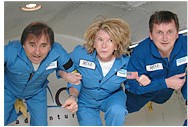
Credits: www.marthastewart.com
Martha Stewart
took a ride on a Zero-G parabolic flyer and later lauded
the experience on her TV show and sponsored
a contest to win a ride.
To her right in the photo is her friend Charles
Simonyi who is on track
to visit the ISS in March 2007. |
|
|
|







